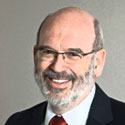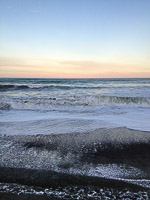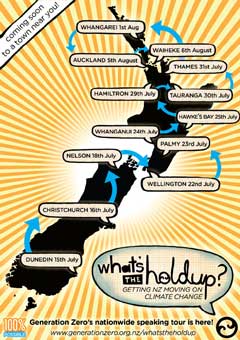 Following the release of a new report on climate change impacts in and around New Zealand by the prime minister’s chief science advisor last week, in my Daily Blog post today I take a look at the government’s reaction. Is it really true that Tim Groser didn’t bother reading the report before spinning out a vapid response? The evidence suggests he certainly didn’t understand what the report was saying, even if he did glance at its content… Comments over there please.
Following the release of a new report on climate change impacts in and around New Zealand by the prime minister’s chief science advisor last week, in my Daily Blog post today I take a look at the government’s reaction. Is it really true that Tim Groser didn’t bother reading the report before spinning out a vapid response? The evidence suggests he certainly didn’t understand what the report was saying, even if he did glance at its content… Comments over there please.
Tag: NZ
New Zealand’s changing climate and oceans: new Gluckman report out today
 The Prime Minister’s science advisor, Sir Peter Gluckman, today released a new report looking at the probable impacts of climate change in New Zealand over the next 40 years. The report, New Zealand’s Changing Climate and Oceans: The impact of human activity
The Prime Minister’s science advisor, Sir Peter Gluckman, today released a new report looking at the probable impacts of climate change in New Zealand over the next 40 years. The report, New Zealand’s Changing Climate and Oceans: The impact of human activity
and implications for the future (pdf) is:
… intended to update the public on current scientific understandings of climate change and ocean acidification. In particular, it focuses on how these changes are likely to affect New Zealand’s climate and industries at a regional level over coming years.
The timing of the report — which appears at first glance to offer a reasonable overview of our current understanding of likely local climate changes — seems a trifle odd. In a matter of months the IPCC will release the first part of its Fifth Report, covering the underlying science, and while we’ll have to wait until March next year for the Working Group 2 report on regional impacts, Gluckman and his team would have had a firmer foundation for their report with only a modest delay.
I’ll be reading the report carefully over the next few days, and will have more to say in due course. I’m particularly interested in exploring how Gluckman approaches the risks associated with local climate changes, and his take on how the wider international context will impact New Zealand.
See also: Peter Griffin, NZ Herald.
Sea level rise and the Canterbury coastline
 What are the prospects for the shorelines of Pegasus Bay as sea level rises, river flows change, and wave directions change? Someone who really knows her erosion from accretion is Sonny Whitelaw, the Hurunui Council’s biodiversity ambassador ((And SF author, writer, photojournalist, and Hot Topic reader.)). She’ll be talking to the Food For Thought Hurunui group on Monday night at the Memorial Library in Amberley, kicking off at 7-30pm. This is a presentation that Sonny has already given to the Waimakariri and Hurunui Councils, and comes highly recommended — especially if you live in or near a Canterbury coastal community.
What are the prospects for the shorelines of Pegasus Bay as sea level rises, river flows change, and wave directions change? Someone who really knows her erosion from accretion is Sonny Whitelaw, the Hurunui Council’s biodiversity ambassador ((And SF author, writer, photojournalist, and Hot Topic reader.)). She’ll be talking to the Food For Thought Hurunui group on Monday night at the Memorial Library in Amberley, kicking off at 7-30pm. This is a presentation that Sonny has already given to the Waimakariri and Hurunui Councils, and comes highly recommended — especially if you live in or near a Canterbury coastal community.
Generation Zero’s NZ speaking tour asks: What’s the holdup?
 Youth-led climate campaigners Generation Zero have just finished the first week of their nationwide What’s The Holdup? speaking tour ((Apologies for not posting in time to promote this week’s South Island events.)) — an attempt to start a national conversation about action to reduce emissions. Here’s what the group has to say about the tour:
Youth-led climate campaigners Generation Zero have just finished the first week of their nationwide What’s The Holdup? speaking tour ((Apologies for not posting in time to promote this week’s South Island events.)) — an attempt to start a national conversation about action to reduce emissions. Here’s what the group has to say about the tour:
In between extreme weather and rising oil prices, countries around the world are making a shift towards renewable energy – but New Zealand is lagging behind. Tackling climate change for many Kiwis feels like an impossible task. But together, we can create the movement to change this and bring forth a thriving New Zealand we are proud to hand on to future generations.
The facts say that it’s 100% Possible to move beyond fossil fuels – but we need leadership at every level, from entrepreneurs and business leaders, from communities, and from the politicians we elect.
Generation Zero will initiate a conversation with the country. New Zealanders young and old are invited to hear young people and experts talk about the solutions to climate change, and what each one of us can do to make a difference.
It’s 100% possible to create a thriving New Zealand beyond fossil fuels. So what’s the holdup?
Here’s the schedule for the remainder of the tour:
- Wellington – Monday 22nd July, Ilot Theatre, Town Hall 111 Wakefield Street
- Palmerston North – Tuesday 23rd July, Massey Uni, Ag Hort 1 Lecture Theatre
- Wanganui – Wednesday 24th July, Wanganui Museum, Davis Theatre
- Havelock North – Thursday 25th July, Havelock North High School Auditorium
- Tauranga – Tuesday 30th July, Bongard Centre, lecture theatre 104, the Bongard Centre, 200 Cameron Rd
- Hamilton – Tuesday 30th July, Waikato University Lecture Theatre S1.04
- Thames – Wednesday 31st July, Life Equip Church, 507 MacKay St
- Whangarei – Thursday 1st August, Whangarei Girls High School theatre
- Auckland – Monday August 5th, Auckland Uni Engineering building, room 401
- Waiheke – Tuesday August 6th, venue Onetangi Community Hall
All events start at 7pm. For more information, sign up here.
NZCCC 2013: Jim Renwick on Antarctic sea ice, SAM and ozone
[soundcloud url=”http://api.soundcloud.com/tracks/96336513″ params=”” width=” 100%” height=”166″ iframe=”true” /]
Here’s the final interview I recorded at last week’s NZ Climate Change Conference in Palmerston North: VUW’s Dr Jim Renwick ((Apologies to Jim for inadvertently using the British pronunciation of his surname in the introduction. I’m told that my usage is a reliable indicator of a migrant from the UK… )) talking about the complex relationship between the southern annular mode — a north-south movement of the westerly winds that blow around Antarctica — sea ice growth and the ozone hole. It’s interesting stuff, not least because SAM has a significant impact on NZ weather and climate, and how it might change in the future is a very big factor in projecting southern hemisphere climates in a warmer world. The abstract of his conference presentation, Antarctic sea ice, the SAM, and the future of the ozone hole, is here.
